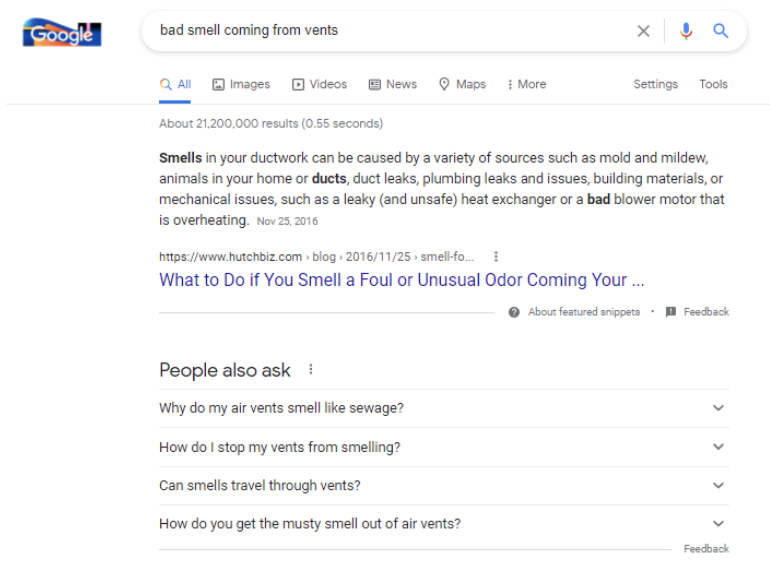Driving organic traffic to your site but not seeing enough conversions? Then your content might not be meeting the users’ needs.
To drive conversions, you need to know what your leads are searching for and deliver engaging content that resonates.
On April 14, I moderated a Search Engine Journal webinar presented by Anna Niles Charity, Senior Product Marketing Manager at CallRail, and Lance Bachmann, Founder and CEO of 1SEO.
They shared how to leverage user intent to drive more qualified, high-converting leads.
Here’s a recap of their presentation.

Effective and engaging content addresses a searcher’s intent – but some businesses miss the mark in this area.
User intent is the main goal a user has when typing a query into a search engine.
For example, your AC cuts out in the middle of the summer, you search [24/7 HVAC repair] while your partner searches [AC repair near me].
While the keywords used for the queries differ, they have the same intent, or end goal, which is to have an HVAC unit repaired.
There are four common types of user intent, namely:
- Informational.
- Commercial.
- Navigational.
- Transactional.
But why does user intent matter?
Simply put: meeting a customer’s user (search) intent is Google’s #1 goal.
The results that Google returns for a particular search query mirrors the intent for that given keyword.
User intent needs is a crucial part of a successful SEO and content strategy.
Here are ways businesses can leverage user intent to inform their marketing.
1. Improve Customer Experience
It’s great to rank for a query, but if users click on your content from the search results and fail to find the answers to their questions immediately, then there’s a high chance they’ll bounce from the page.
This translates to a lost opportunity to convert that visitor into a lead or a customer.
If Google sees that more users are leaving the page than staying to read and engage with your content, you might even see your rankings begin to drop.
This is what happened with a client of Bachmann and his team – a dental office that provides full-service and urgent care.
To address this issue, they decided to cut through the fluff in their website content and get to the most important answers.
They geared the messaging and content to answer questions and provide the next steps for a specific type of user – people in need of emergency dental care.
The adjustments led to great rankings, including the #1 position for “emergency dentist in Philadelphia.”
Not only did they find success in the SERPs, but it also brought them a consistent stream of highly qualified leads.
2. Leverage Data to Make Informed, Data-Driven Content Updates
Generating new content isn’t the only way to meet users’ needs.
If you have a lot of content on your website that’s already gaining traction, being indexed by search engines, and ranking in the top 30-50 positions, it might be best to expand your content and make them better.
A variety of data sources can help you uncover insights on user intent and make informed decisions when it comes to your content – Google Search Console (GSC) is one of them.
Using GSC is a great way to:
- Uncover what queries your site (or a particular page you want to rank) are getting impressions and clicks for.
- Decide if your page actually does a good job of answering those user’s needs.
Segmenting your Google Search Console data to be question-focused will help you see what questions your users are searching that may be tied to your industry.
If you want to better rank in the future, you should aim to provide a clear, concise answer to those questions.
Looking at Google Analytics can also tell you a lot about whether your page is meeting people’s intent.
Does your page have a low time on page and high bounce rate?
This is another area you should investigate.
You may be ranking for something but when users get to your page they leave immediately because they are not getting what they thought your content has.
This is a big indicator that you need to make updates on your content.
Bachmann and his team encounter this issue often with several of their clients.
One client in the gambling niche saw the huge shift to mobile and online gambling as an opportunity to educate users who were trying to justify online gambling due to it seeming less dangerous than visiting an actual casino.
So they laid out tons of great stats, sources, videos, and infographics into one all-encompassing blog.
They ended up taking the #1 position for relevant terms such as “is online gambling dangerous”.
The client was able to get ahead of the curve and answer a lot of relevant questions that also contributed to boosting awareness of their brand.
This strategy also worked well for another client in the HVAC sector.
A lot of companies trying to rank for terms related to common HVAC problems tend to lean too heavily on the call to action “Call us today” instead of educating users on what may actually be happening.
Going against the norm, they put together a blog post that discussed multiple different kinds of smells for different problems with the aim to address everyone’s concerns.
The blog post has amassed nearly 100,000 visits since its inception, targeting a specific type of user intent.
The best part?
It ranks at the top of Page 1 with a featured snippet and converts at over 3% – which for a blog post for a local company is pretty unheard of.

3. Increase Time on Site & Conversion Rates
Users are skimmers – they’re coming to your site to get an answer or a need met.
It’s essential to be aware of how your users are seeing, engaging, and behaving when they’re on your website.
This is why you need to optimize your webpages to deliver the best experiences for real users, not just search engines.
You can gauge your web performance by tracking your Core Web Vitals metrics.
Another way to keep users engaged and increase the likelihood of conversion is to take advantage of proper page structure and layout.
By laying out your page in an organized and succinct manner, you not only make it easy to understand for users but also for bots crawling your site.
Using subheadings correctly and creating a nice flow of information will ultimately help the page rank and perform stronger.
[Slides] 3 Powerful Ways SEO User Intent Drives Higher Lead Quality
Check out the SlideShare below.
Image Credit
Screenshot taken by author, May 2021
Join Us For Our Next Webinar!
The Data Reveals: What It Takes To Win In AI Search
Register now to learn how to stay away from modern SEO strategies that don’t work.


